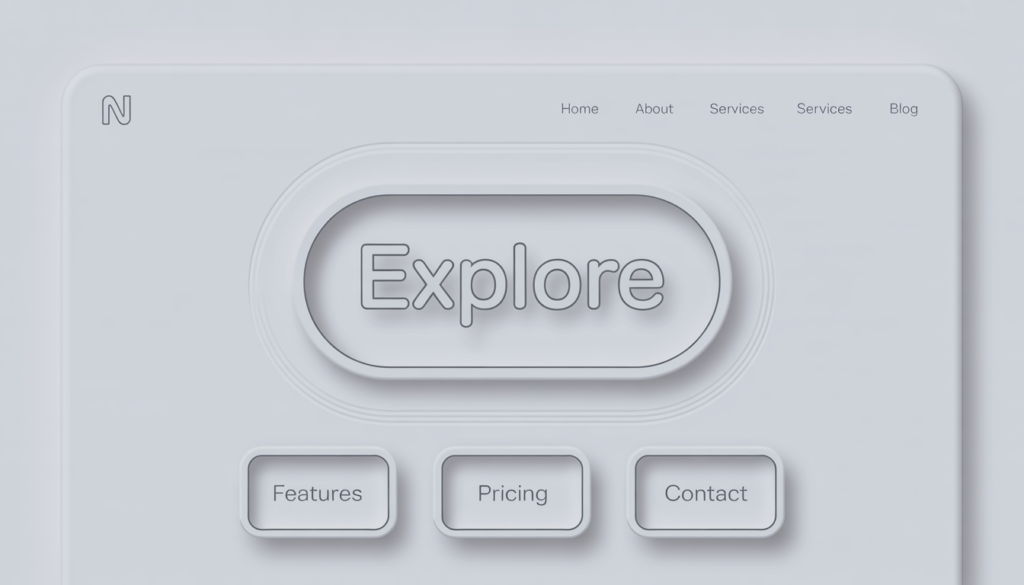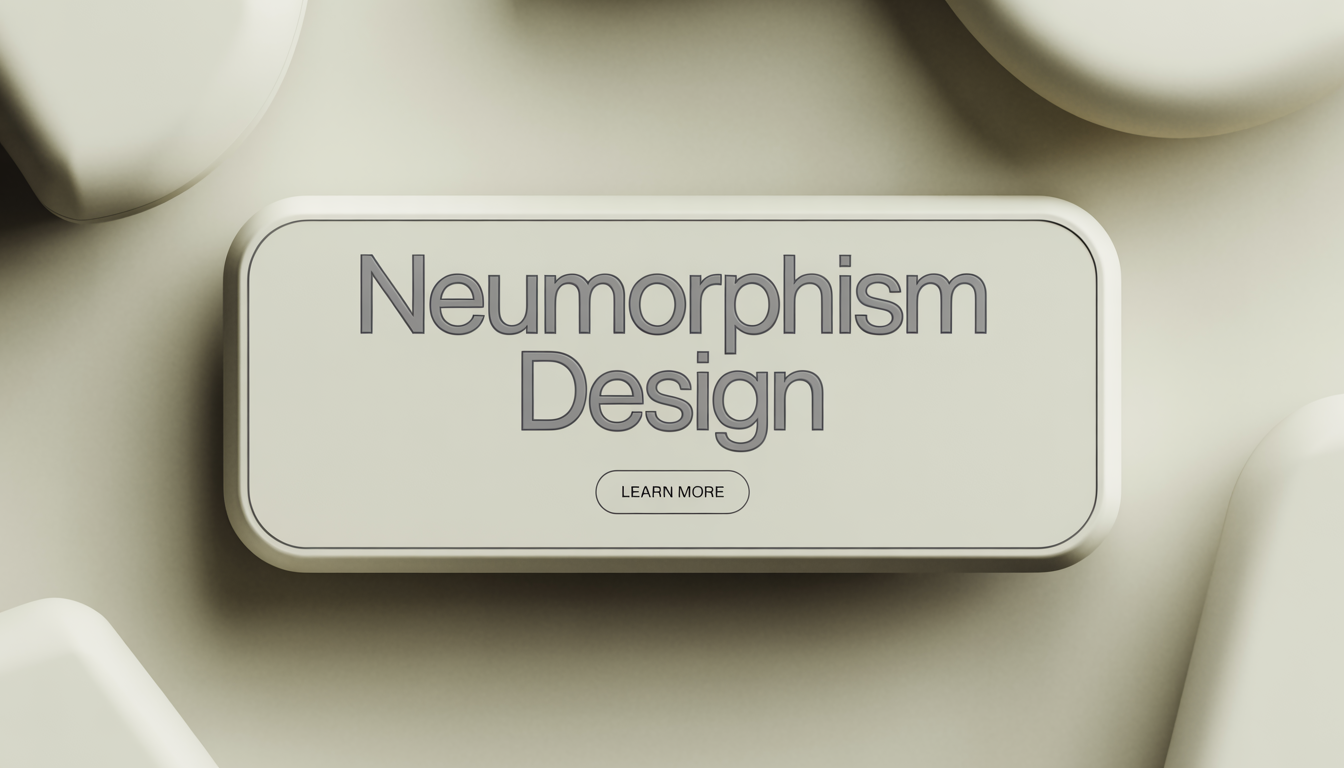A new trend has emerged in digital graphic design, changing how we see modern UI design. Neumorphism design combines the feel of skeuomorphism with the simplicity of flat design. It has quickly become a symbol of advanced design, changing the user interface world.
Neumorphism, or Soft UI, uses light and shadow to create elements that feel real. It gives digital designs a three-dimensional look that feels almost touchable. This design trend brings a sense of familiarity and realism to digital spaces.
The digital world is moving towards more engaging and immersive experiences. Neumorphism in UI design is leading this change. It makes interfaces both beautiful and easy to use. In the next sections, we’ll explore what makes Neumorphism stand out in digital design.
What is Neumorphism Design?
Neumorphism UI design, also called Soft UI, blends the look of skeuomorphism with flat design’s simplicity. It creates a user interface that feels both new and familiar. This design trend is known for its soft shadows and light effects that make digital elements seem real.
Neumorphism stands out in user interface design by focusing on color, depth, and dimension. It makes digital interactions feel more real. Using gradients and soft shadows, it brings a touch of the physical world to digital interfaces.
This style is quickly becoming popular for its ability to make digital interfaces more accessible and visually appealing.
The Aesthetic Appeal of Neumorphism
The beauty of neumorphic style in digital design is its ability to make screens feel real. It uses soft shadows and highlights to make digital elements seem like they’re part of the real world. This makes apps look better and feel more real to users.
Neumorphism often uses simple colors, like soft pastels. This makes the design easy on the eyes and simple to use. The shadows and highlights add a touch of elegance, making the interface both beautiful and functional.
Neumorphism is becoming more popular in design because it’s simple yet interactive. It’s a key part of modern design trends. It balances minimalism with a sense of depth that flat designs can’t match.
Advantages of Neumorphism Design
Neumorphism design is becoming more popular for its ability to make websites look better and feel more real. It uses techniques that make digital applications more visually appealing and easier to use.
One big plus of neumorphism design is how it makes digital things feel like real objects. The soft, 3D look of elements in a neumorphic website makes them feel like you can touch them. This makes users feel more comfortable using the controls, which are designed to look like everyday objects.
Also, neumorphism design helps apps stand out from others. In a busy market, apps with neumorphic design grab attention faster. Their unique look, with shadows and highlights, creates a soft yet striking depth. This not only draws people in but also keeps them coming back for more.
Lastly, neumorphism design gives users natural cues as they navigate. This makes digital interactions feel more natural and organic. It leads to better usability and more user engagement, making neumorphic design a lasting trend in web development.
Challenges of Implementing Neumorphism
Neumorphism ui design brings a unique and futuristic look to user interfaces. Yet, it also presents challenges for designers. One major issue is accessibility. The use of shadows and light can lead to low contrast levels, affecting users with visual impairments.
Designers must balance beauty with functionality to ensure everyone can use the interfaces. This balance is key to making interfaces accessible to all.
The sophisticated shadow and gradient effects in Neumorphism require strong graphic capabilities. These effects can slow down apps, mainly on mobile devices. It’s important to optimize these elements without losing the design’s essence.
Designers need to test these elements on various devices and platforms. This ensures the design works well everywhere.
There’s also a risk of using Neumorphism too much. When overused, it can make interfaces cluttered and confusing. Designers must use this style wisely to avoid overwhelming users.
Despite the challenges, Neumorphism remains a thrilling trend in user interface design. It challenges designers to find ways to make digital aesthetics both beautiful and usable.
Best Practices for Neumorphic Design
Designers should aim for a balance of light and shadow in neumorphic UI. This balance is key to creating depth without losing clarity. Using soft shadows helps keep the design clean and prevents clutter.
Choosing the right colors is also crucial in neumorphic UI. Muted colors with warm tones work well with the minimalist style. Gradients that mimic natural light add realism and feel without being too much.

Usability is a top priority in neumorphic design. While the design should look great, it must also be practical. Designers should make sure the design doesn’t get in the way of how users interact with it.
To succeed in neumorphic design, focus on visual details and user needs. Balance, subtlety, and functionality are key. This way, designers can create designs that are both beautiful and easy to use.
Neumorphism vs. Flat Design
When we look at Neumorphic and flat design, we see two different ways to design websites. Neumorphic uses shadows and gradients to make websites feel like real objects. This makes websites more interactive and easy to use.
Flat design, on the other hand, focuses on simplicity and clarity. It removes unnecessary details to make websites clean and easy to navigate. This design uses bold colors and simple shapes to improve usability.
Choosing between Neumorphic and flat design depends on what you want to achieve. Neumorphism adds depth and texture, making websites more engaging. Flat design, with its simplicity, is better for fast and clear websites. The right choice depends on the user’s needs and the project’s goals.
Popular Applications of Neumorphism
Neumorphic elements are becoming a big trend in digital design. They are seen in many digital interfaces. For example, sleek website landing pages and mobile apps use neumorphism to make user interactions more engaging.
This design choice adds a tactile sense that is both beautiful and practical. It makes simple tasks more interesting and easier to do.
In mobile apps, neumorphism is about more than looks. It makes tasks visually appealing and easy to do. Soft shadows and light features hint at what you can do next.
This is key in apps like fintech or healthcare. Neumorphism makes the app feel intuitive and trustworthy. This helps keep users coming back.
In digital product interfaces, neumorphism blends old and new design. It creates innovative user experiences. The tactile nature of neumorphism makes users feel connected to the app.
It improves usability by showing where to tap or click. This is important in making apps like fintech or health apps more user-friendly.
Neumorphism is promising in making digital interfaces better. It combines function with beauty. This makes it a key trend in digital design’s future.
Tools and Resources for Neumorphism Design
Starting your Neumorphism UI design journey? There are many tools and resources to help you. Design tools like Figma, Sketch, and Adobe XD are key. They offer features that help with the details of neumorphic design.
These platforms let designers play with soft shadows, gradients, and layers. These are key to the neumorphic style.
Looking for more knowledge? There are many online tutorials and courses out there. They give step-by-step guides and tips on making great Neumorphism UI designs. They’re good for beginners and pros alike.
Community forums are also a great resource. They’re for sharing ideas, solving problems, and staying updated on neumorphism trends.
Plugins like Neumorphism.io make your work easier. They help you add neumorphic elements to your projects smoothly. These tools work well with your design software, helping you create more efficiently.
Future Trend Predictions for Neumorphism
The future of Neumorphic UI in modern UI design looks exciting. It will blend tactile and visual elements, making digital spaces more real and engaging. This style will meet user needs by offering a unique and realistic experience.
Neumorphism will team up with trends like dark mode and minimalism. This mix will make Neumorphic UI even better. It will focus on both looks and function, making digital interfaces easier to use. Dark mode, in particular, will create a calm and less straining visual experience.
Sustainability will also shape the future of modern UI design. Designers will aim to make digital solutions eco-friendly. Neumorphism will need to be adapted to be energy-efficient without losing its unique look. This balance will be key to its success.
Looking ahead, Neumorphic UI promises to improve how we interact with digital spaces. It will fit into current design trends and values. Its success will depend on how well it meets user needs and supports sustainability.
Case Studies: Successful Neumorphism Implementation
Looking at how big brands use neumorphic design shows a clear path to success. These examples show how neumorphic design looks good and works well. They also show how it makes users more engaged and connected to the brand.
A leading tech company changed its digital look by adding neumorphic elements. This made the site feel softer and more interactive. Users loved the new feel, saying it made the site feel more real and personal.
An emerging fintech startup also used neumorphic design to make digital banking easier. The soft shadows and light made the site clear and simple. This made users trust the site more and stay longer.
These examples prove that neumorphic design is worth the effort. It makes sites not only work well but also show what a brand is all about. It connects with users on a deeper level.
How to Get Started with Neumorphism
Starting your first neumorphism design project is thrilling. It’s a step into the world of modern user interface design. Neumorphic UI is known for its soft, three-dimensional look. It uses shadows and gradients to make digital elements feel real.
As a beginner, it’s key to grasp the basics of neumorphism. This style is different from others. It focuses on creating a sense of depth and physicality in digital designs.
Start by trying out tools that support neumorphic design. These tools help you see how light and shadow work together. They create the ‘inset’ and ‘outset’ looks that are key to neumorphic UI.
Play around with different depths to learn how shadows can make designs feel tactile. This adds to the user’s experience.
Getting feedback from users is essential. Neumorphism relies on small visual details. It’s important that your design is both beautiful and easy to use.
Ask users about their experience with your design. Their feedback is crucial. It helps you make your neumorphic elements both attractive and practical.
Keep improving your designs based on what users say. This ensures your neumorphic UI looks great and works well. Remember, mastering neumorphism takes time and practice. It’s a journey of learning and growth in user interface design.
Conclusion: The Future of Neumorphism in UX/UI Design
Looking ahead, digital graphic design is set to evolve. Neumorphic style has made a big impact in UI design. It brings a new feel to screens, making them more like real objects.
This style combines digital and physical elements in a unique way. It takes old textures and buttons and makes them modern again. This makes screens feel more real and interesting.
But, there’s a catch. Neumorphism needs to be both beautiful and functional. Designers must focus on making it easy for everyone to use. This means making sure it’s accessible and clear for all users, including those with visual issues.
Designers need to use technology and creativity to make neumorphism work well. They should aim to make it both beautiful and easy to use. This way, neumorphism can continue to improve user experiences.
The future of neumorphism looks bright. UX/UI designers have a chance to make it even better. By listening to user needs and staying up-to-date with accessibility, they can keep making neumorphism great. It will play a big role in the future of digital design, opening up new possibilities.



